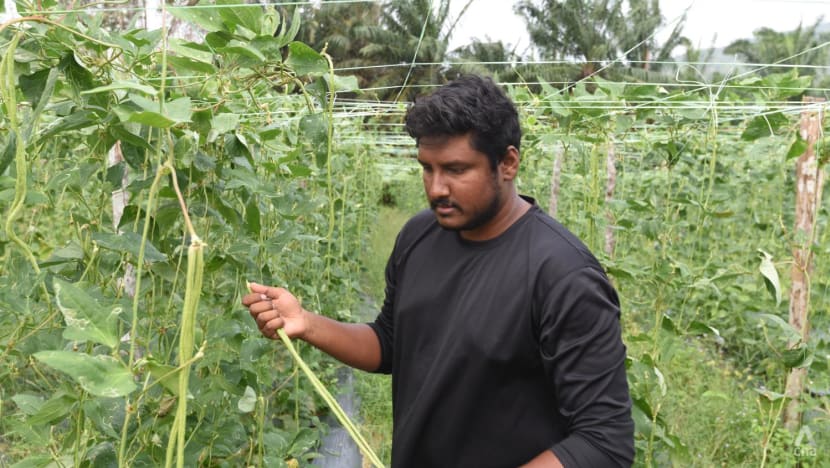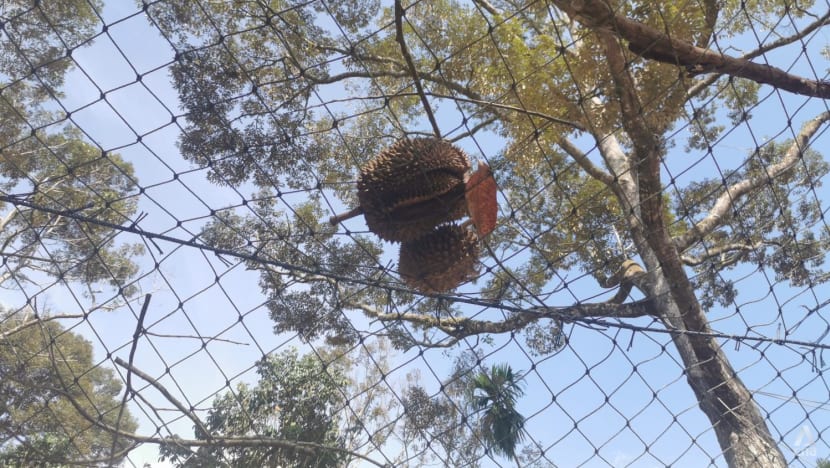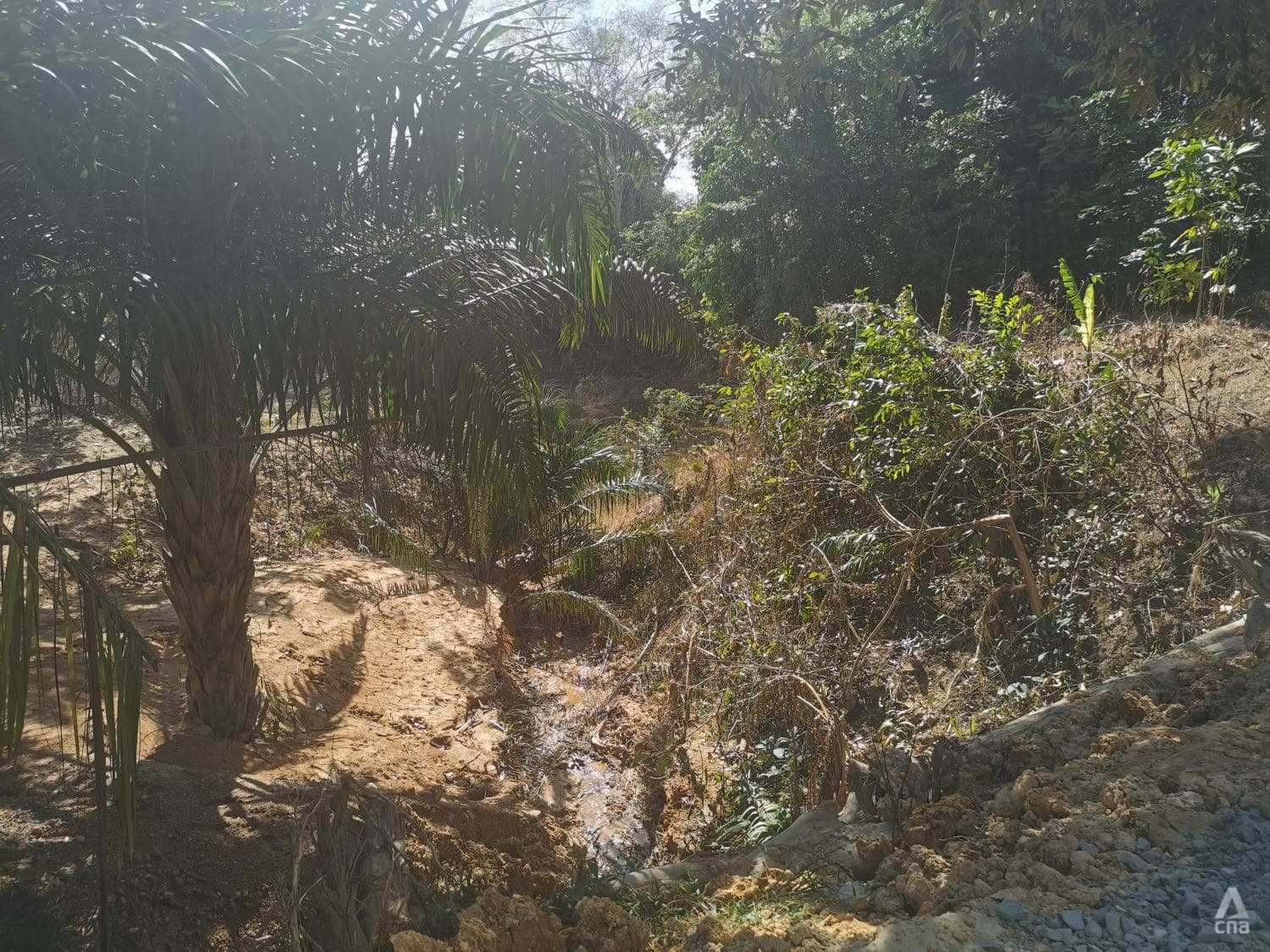'All 2,000 cucumbers died': Shortage of vegetables, durians from Johor as crops destroyed by floods and heat

Farmer Naviin Thiagarajan said his crop yield has been impacted by recent erratic weather in Johor. (Photo: CNA/Amir Yusof)
JOHOR BAHRU: Farmer Naviin Thiagarajan plans the planting of his crops based on an understanding of decades-long established weather patterns in Malaysia.
The 28-year-old, who works on a 2 ha land near Kota Tinggi with his 54-year-old father, rotates between planting long beans, okra and cucumbers across the rainy and hot seasons.
However, Mr Thiagarajan said that these once-reliable plans are in disarray as the weather has recently become more extreme and erratic.

“From last year (2021) onwards, we started to see how unpredictable the weather has become. And over the last month, the weather has truly epitomised what I have read about climate change,” he told CNA.
At the start of the new year, many parts of the southern state of Johor saw torrential downpour, leading to floods that displaced thousands of residents.
The floods also hit many farms, destroying crops and impacting the livelihoods of many in the industry.
However, what has perplexed many farmers is how this period of intense and heavy rain has been followed by warmer weather in the last two to three weeks, with lower rainfall across the state.
Between Dec 26 and Jan 1, at the height of the Johor floods, data released by the Johor Department of Irrigation and Drainage showed that the city of Johor Bahru had 1,448mm of rainfall, according to Malaysian media reports.
In comparison, Johor Bahru recorded 515.3mm of rainfall between Jan 1 and Jan 27, according to estimates on weather.com
The average maximum temperature in the area was 30.6 degrees Celsius between Dec 26 and Jan 1. This edged up to 31.8 degrees Celsius between Jan 1 and Jan 27.
The period between November and March is synonymous with the northeast monsoon, which usually leads to heavy rain in many areas of peninsular Malaysia. Hence the recent spate of warm weather has caught many farmers by surprise.
“The floods have of course destroyed many crops,” said Mr Thiagarajan.
“But the last two weeks of no rain and high temperatures have been just as bad. I planted 2,000 cucumbers and all of them died because of the heat,” he added.
Mr Thiagarajan explained that some of his okra and long beans died from excessive rain in late December. But he maintained that this pales in comparison to the losses sustained due to the warmer and drier weather in January.
He estimates that he may have lost around 10,000kg of cucumber due to the warm weather, with a financial loss of around RM8,000 (US$1,909).
He is not alone. Other farmers in Johor have echoed similar sentiments. They told CNA that erratic weather between late December and early January has led to produce shortages at an inopportune time, amid rising demand for fruits and vegetables ahead of Chinese New Year next week.
Mr Mad Zin Abdullah, who owns a durian plantation in Kampung Tengah in Segamat, told CNA that his crop yield in December was “washed away” by the flood water which infected the roots of many of his trees.
Segamat was among the worst-hit areas when floods hit Johor in early January.
“The floodwater was this high,” said Mr Mad Zin pointing to his chest.

“I had some suppliers asking (for durians) but there was none available to sell,” he recounted.
The veteran farmer, who is in his 70s, told CNA that the prolonged hot weather which followed the floods has dried up most of his plantation. However, this does not necessarily mean that the conditions are now conducive for growth.
“There was no balance between moisture in the soil and the right temperature. We will have to wait to see if there will be more durians in a few months,” he added.
Chairman for the Yong Peng vegetable farmers’ association Cheng Tai Hoe told CNA that the floods had destroyed around 30 per cent of the crops in farms in affected areas across Tangkak and Segamat.
He added that the floods, followed by prolonged hot weather, has further curtailed the growth of produce ahead of Chinese New Year. Examples include cucumber and bitter gourd.

“When it rained, the roots were impacted by fungus in the soil … Quickly followed by prolonged hot weather, many seedlings will wither and die,” said Mr Chen.
Mr Chen added that many farmers in Johor have been unable to overcome this shortage. As a result, the prices of fresh produce have gone up, including those sold at local markets and exported to Singapore.
“We are operating based on demand and supply in the market economy. Because many farmers are unable to meet this shortage, prices will be high. Only those who can afford it will be able to pay for some of these vegetables,” he added.
ADAPTING TO CLIMATE CHANGE
Environmentalist Renard Siew told CNA that what these farmers in Johor are experiencing is in line with the report released by the Intergovernmental Panel on Climate Change (IPCC) last August.
The report stated that climate change was intensifying the water cycle, bringing about more intense rainfall and associated flooding. It added that climate change could also lead to more intense drought in many regions.
Dr Siew, who is the climate change advisor to the Centre for Governance and Political Studies (Cent-GPS), a Malaysia-based behavioural and social science research firm, said that the erratic weather patterns in Johor quite clearly reflects the climate change phenomenon.
He said: “Farmers were hit with a double-whammy effect. Their crops will be hit by severe floods followed immediately by long periods of drought.”
One aspect of the phenomenon, he said, is how floods will wash away the crops. Additionally, every 1 degree Celsius increase in the earth’s temperature will lead to a 2 per cent to 3 per cent decline for the yield of key agricultural produce, he noted.
Some farmers are beginning to recognise the growing challenges. Mr Thiagarajan, who has been reading up on the impact of climate change on agriculture, said he finds it difficult to adapt to erratic changes in weather patterns.
“Climate change is real so we have to adapt and try to move forward and work around it. My dad and I always look at the weather report and try to plan ahead,” he said.
However, many of the farmers in the state are still unfamiliar with the concept of climate change.

When asked by CNA if the recent decline in crop yield may have been caused by erratic weather linked to climate change, durian farmer Mr Mad Zin said he was unsure.
“I’ve done this since the 1970s and there have been floods before. But we ride through it again and again,” he stated.
Dr Siew said the dialogue on climate change in Malaysia needs to encompass all communities, inducing rural farmers who may be directly impacted.
“Conversations around probability, likelihoods and severities, for the layperson it may be difficult to digest. There is something to be said to the need of gaining awareness of climate change to the rural people as well,” he added.
To help farmers cope with these erratic changes in weather, Dr Siew said that the authorities should educate the public about a need to build agricultural resilience.
He explained that this can be done by using technology for precision agriculture. This means using precise parameters of soil acidity, water and sunlight to maximise crop yield.
He added that the concept of vertical farming may also be introduced. This involves using warehouses and greenhouses instead of open land which are exposed to the elements.
Kota Tinggi farmer Mr Thiagarajan also expressed hope that either state or federal authorities would extend help to farmers whose livelihoods will be impacted in the future.
“We need help with resources and advice. If only the agricultural department could help directly in advising us how to do crop set up, maintenance, amid the challenges of climate change. It will be a great help for many farmers,” he added.



No comments
Share your thoughts! Tell us your name and class for a gift (: